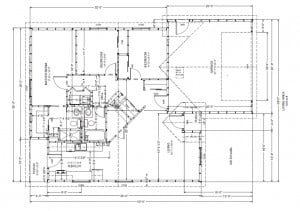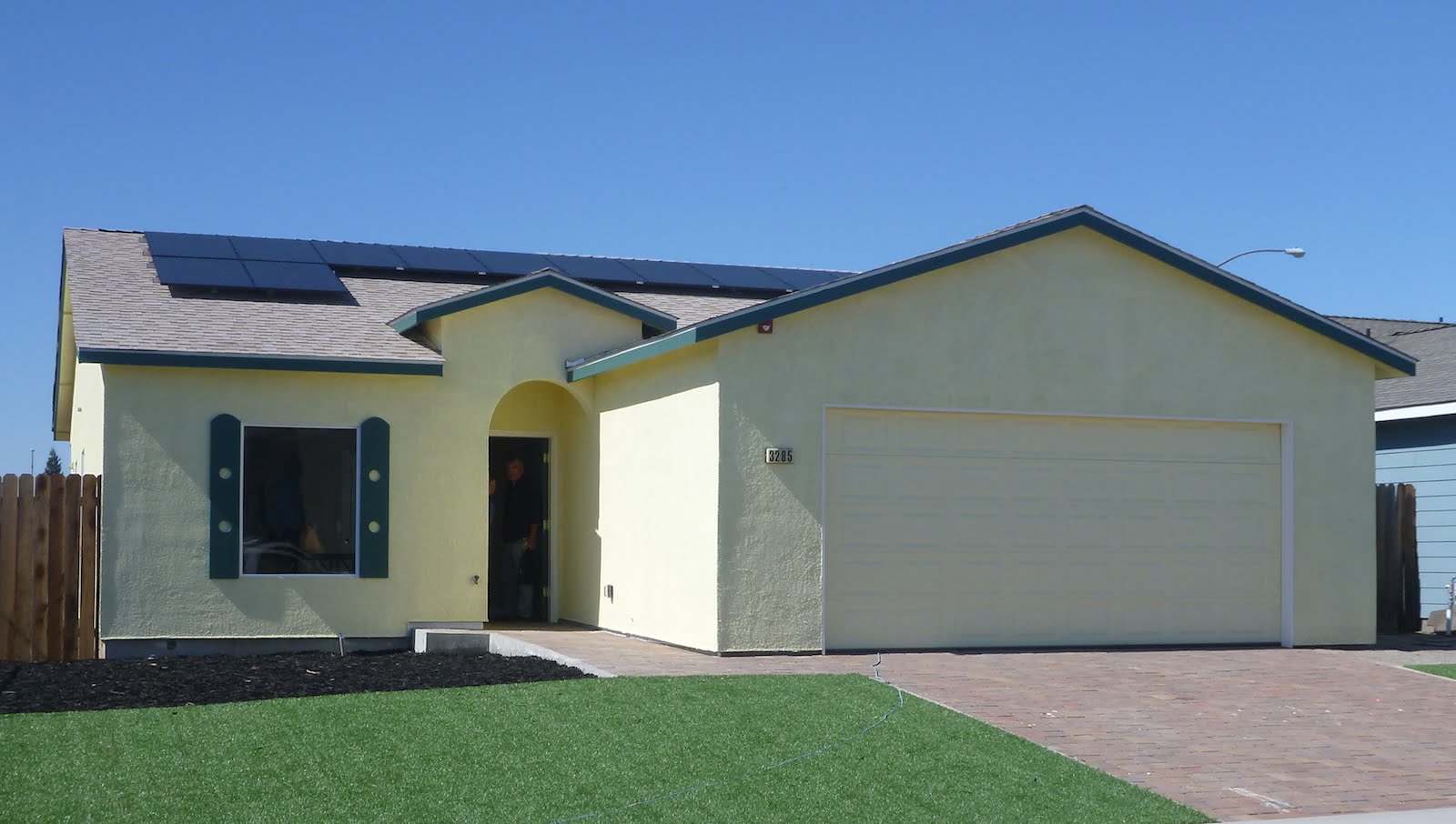In an effort to find ways to make zero energy homes more affordable, San Joaquin County Habitat for Humanity (SJC Habitat) went farther than most. The non-profit organization found ways to make their zero energy homes cost less to build than their standard, moderately energy-efficient homes. A recent report on one SJC Habitat project documents almost $3,000 in construction cost reductions even as they brought the home to the zero net energy standard. Labor and material costs were reduced for heating and cooling, ductwork, water heating, and other measures. How did they achieve these savings? The key was intelligent design and planning.
Heating and Cooling Equipment
One striking cost reduction occurred in the heating and cooling system. Earlier homes built in this subdivision included a 60,000 Btuh gas furnace and a 3-ton (36,000 Btuh) air-conditioner. Heating and cooling loads were slashed by 75% with design changes and shell efficiency measures. The large gas furnace and air conditioners used in previous SJC Habitat homes were excessive. Instead, a ducted mini-split heat pump, which both heats and cools and is capable of producing 19,000 Btuh, was installed for a cost savings of $2,000. Properly-sized heating and cooling systems reduce construction costs, cut energy use, and improve occupant comfort by reducing on-off cycling.
Ducts Inside
Ducting offered another chance to reduce mechanical equipment costs. A dropped ceiling in the central hall enclosed the mini-split’s small air-handler and ductwork. This space was fully enclosed and sealed to ensure that it was in conditioned space. The central location, short duct runs, and easy access made this internal duct system more direct and less expensive than typical ductwork that meanders through attics or crawlspaces. The net result was a $600 savings on construction cost and more efficient operation.
Water Heating
In most homes, water heaters are located in a basement or garage, often far from the end fixture. This demonstration home placed the water heater in a central utility room to reduce the length of hot water pipe needed. This compact hot water system saved $470 and was made possible by placing the hot water fixtures close to one another during the design phase. The design team worked closely with the construction manager to make sure that the ideas on paper made sense and could be effectively applied in the field.

Strategies for Additional Savings
An array of smaller savings resulting from intelligent design added up to a big impact. Here are two examples. Using advanced framing techniques (studs 24-inches on-center, single top plates, etc.) reduced material and labor cost. More insulation and air sealing did increase costs slightly, but reduced the need for solar electric panels resulting in a net reduction in cost. This holistic, highly-integrated approach, involved bigger outlays in some areas of labor, materials and equipment, but resulted in savings that more than offset other expenses for key energy efficiency strategies. These economies essentially paid for all the energy upgrades according to the comprehensive report on the project.
Air Sealing
Air sealing is a highly cost-effective way to reduce energy use due to space heating and cooling. The team accomplished an impressive reduction in air leakage – down from 4.75 ACH50 in previous homes to 1.5 ACH50 in this demonstration home. While operable windows are essential for emergency egress and desirable for natural ventilation, not every window needs to open. Non-operating windows, which cost less, were specified where possible. To save energy, window area was reduced, which also reduced costs. Recessed lights were eliminated due to the high rate of air leakage they create. Attic and crawlspace access hatches were located so that they didn’t penetrate insulated floors or ceilings. To create a continuous air barrier, all seams in the structural sheathing were caulked. These air sealing measures were tested at the rough framing stage with a blower door and smoke generator, allowing workers to find and seal leaks earlier in the construction process. Advanced air sealing is one practice that any builder can employ to reduce energy use at a relatively low cost.
Other Zero Energy Features
Like all Habitat for Humanity homes, this one demonstrates one design element that advances both affordability and net zero energy use. It is small. The 1,200 square-foot home is one story, with three bedrooms and two baths. Comfortably sheltering a family of four in 1,200 square feet is a key step to affordability.
To reach zero energy, SJC Habitat employed many other tried and true energy saving techniques. Keep in mind that these homes are located in California’s Central Valley which sees scorching summers so cooling is an important design consideration. Other techniques employed include:
- Wall cavity insulation increased from R-11 to R-21
- 1” (R5) exterior rigid insulation added
- Windows upgraded to lower U-value and higher Solar Heat Gain Coefficient
- Reduced window area
- Radiant barrier roof sheathing added to control solar heat gain
- Low-cost heat recovery ventilation with two Panasonic energy recovery ventilators (ERVs)
- LED lights throughout
Solar tube skylights were not selected for the project. The designers decided that the heat gained and lost through this opening in the thermal envelope was more significant than the small amount of electricity that would be used by LED lights.
Rooftop Solar Electricity
By emphasizing shell and mechanical system efficiency, the annual energy needs of the home and its occupants can be supplied by a relatively small, 3.36 kiloWatt, rooftop solar system, the same size used on their standard non-zero energy homes. Although solar prices have dropped radically over the last few years, solar remains the most expensive component of a zero energy home. A key element of affordability is minimizing energy use and the resulting size of the on-site renewable energy production system.
ZNE Demonstration Program
For Habitat for Humanity, keeping construction cost low is essential to their mission to build homes that are simple, decent, and affordable. While already interested in lowering energy and water costs for their home owners, SJC Habitat wanted to take it a step farther. So they participated in the Zero Net Energy (ZNE) Production Builder Demonstration offered by Pacific Gas & Electric. Consultants Ann Edminster, Steve Easley and Rick Chitwood provided technical assistance to the project. This project worked out so well that the features, materials, and practices from the demonstration will become standard practice for future SJC Habitat builds. The full report on the project is extremely informative and includes photos of construction details, energy modeling results, cost data, and process evaluations.
Affordability through low utility bills is essential for the families living in Habitat for Humanity homes. That’s why most Habitat affiliates have been adopting more energy-efficient construction practices. Although this is not the first Habitat project to achieve zero energy, the significance of this project is that it refines and quantifies the many elements that make zero energy homes truly affordable. And it resulted in a zero energy home that cost less to build – not to mention less to own – than a standard energy-efficient Habitat home. These cost reductions were achieved by intelligent planning during the design phase.


One thought on “Simple Techniques for Lowering the Cost of Zero Energy Homes”